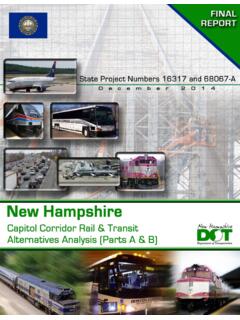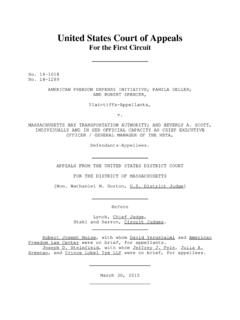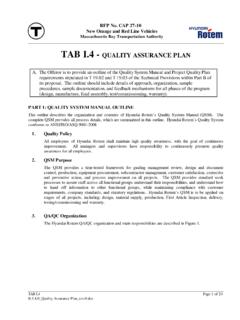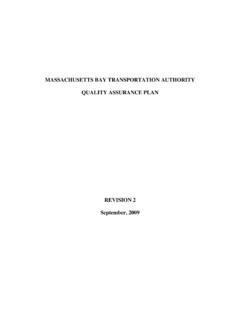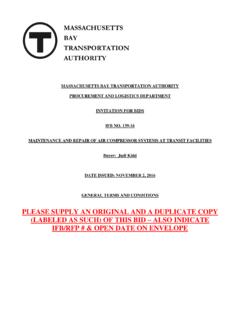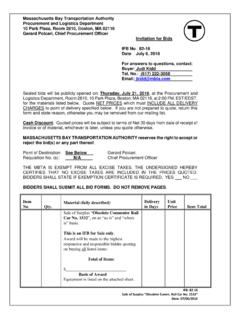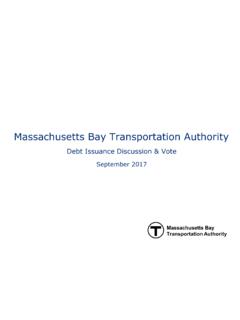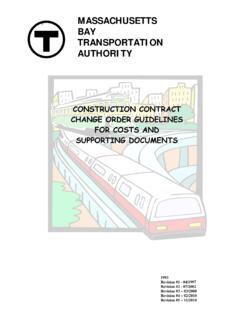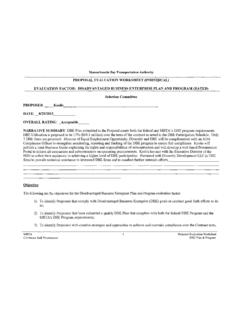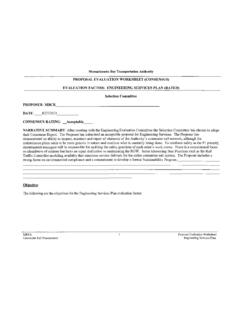Transcription of Assignment 2 Elasticities Consumer Surplus
1 / / transportation Systems Analysis: Demand and Economics Assignment 2 Question 1 Elasticities and Consumer Surplus In April of 1973, the massachusetts Bay transportation authority (MBTA) initiated an experiment called Dime Time. On weekdays between the hours of 10am and 3pm, the fare for travel on the MBTA s rail lines was reduced from 25 cents to 10 cents, but was 25 cents during all other hours. During the Dime Time experiment, which lasted until August 1975, fares for bus travel remained at 20 cents per ride during all hours. The Dime Time experiment provided an unusual opportunity to evaluate the sensitivity of midday rail transit demand to a reduction in fare, a subject of interest to many transit operators and planners. Relevant data from the experiment are presented in Table 1. a. Using the data provided in Table 1, estimate the fare elasticity of total weekday demand for MBTA rail transit service during midday (10am 3pm). b. According to this elasticity estimate, is the demand for midday rail transit service elastic or inelastic?
2 Comment on your answer. c. How does the elasticity of demand for midday rail transit service vary among the three income groups (low, moderate, and high) for which ridership data are reported in Table 1? Comment on these variations. d. Table 1 also reports the prior behavior of MBTA rail transit passengers traveling during Dime Time hours. Boston s regional transportation planning agency estimated that 233,760 auto trips (including both driver and passenger trips) were made in the MBTA service area on a typical weekday before the Dime Time program began. From these data, estimate the cross elasticity of demand for auto travel with respect to fare for midday rail transit trips. How do you interpret the ar ithmetic sign of this elasticity? e. The MBTA estimated that prior to the Dime Time experiment, average weekday travel on the rail service during peak periods (7 10am and 3 6pm) was 203,670 passengers. Estimate the cross elasticity of demand for peak period rail travel with respect to the off peak rail fare.
3 F. Please answer the following: i. What were the total daily benefits to riders, as measured by the increase in Consumer Surplus , of the Dime Time experiment? ii. How much of the increase in Consumer Surplus represented fare savings to passengers who already traveled on the rail system during the midday at the initial fare of 25 cents? iii. How were the benefits in (ii) divided among riders in the three income groups? iv. How much of the total benefit was received by new riders (who were initially not using the T) who began to use the rail system when the midday fare was reduced to 10 cents? v. How were the benefits in (iv) divided among riders in the three income groups? g. Why is it important to distinguish between Consumer benefits to passengers who had been using the rail system at the higher fare and those received by new riders who began to use the system in response to the fare change? Table 1: Average weekday MBTA rail transit passengers between 10am and 3pm with Dime Time , by previous mode of travel and income class1 Income class Previous travel mode Low Moderate High Total MBTA rail transit 7 am 10 am 370 215 175 760 10 am 3 pm 9,500 8,250 5,100 22,850 3 pm 6 pm 255 165 135 555 MBTA bus transit 1,080 680 340 2,100 Private automobile Driver 895 525 400 1,820 Passenger 220 75 80 375 Walk 850 380 90 1,320 No previous trip 1,850 570 90 2,510 Total 15,020 10,860 6,410 32,290 Note on interpretation of this table: This table shows the average number of people who traveled via rail between 10am and 3pm during the Dime Time experiment.
4 The different categories tell us what mode these people used before switching to rail. So, for example, we know that the total number of people riding the rail system during off peak hours under Dime Time was 32,290. Of these 32,290, 22,850 passengers rode during these hours before the lower fare was introduced. 2,100 of the 32,290 previously rode the bus, but switched over to rapid transit with the new lower fare. 1 Income classes are defined as follows (measured in 1975 dollars): Low, 0 $10,000 per year; Moderate, $10,000 $20,000; High, over $20,000 per year. 2 Question 2 Using the Logit Model The first step in the application of a Logit model is the specification (and estimation) of the utility functions for the alternative modes. Let s assume that the following utility specifications are available: V(auto) = * (auto TT) * (parking cost) + * (HH income) V(bus) = * (bus TT) * (bus WT) * (bus fare) where V(auto) and V(bus) are the systematic utilities of auto and bus respectively; (auto TT) is the travel time for the auto mode (in minutes); (HH income) is the household annual income (in dollars); (parking cost) and (bus fare) are in dollars; (bus TT) is the travel time for the bus (in minutes); (bus WT) is the waiting time for the bus (in minutes).
5 For simplicity let s assume average waiting time to be half the headway. Table 2 shows the characteristics of work trips for two population segments. (Think of segment A as people living near the center of a city and segment B as people living in the suburbs. People in both segments all work in the downtown area.) Table 2: Characteristics of work trips for two population segments Segment A Segment B Variable Auto Bus Auto Bus Auto Travel time (min) 25 40 Parking cost ($) Bus fare ($) Bus travel time (min) 40 60 Bus headway (min) 15 20 Household annual income ($) 40,000 80,000 a. Based on the information in Table 2, compute the probabilities that an individual belonging to each segment will choose auto for a work trip. b. In order to increase transit ridership, the local transport authority considered the following options: i. Reducing the fare by 50 cents in both segments. ii. Doubling the number of buses on each route (which would halve the headways).
6 Iii. Doubling parking costs For each population segment, how will each of these strategies affect transit ridership, and which option will be most effective in increasing ridership? c. What monetary value of bus travel time, measured in dollars per hour, is implied by the coefficients of this model? 3 Question 3 Using the Four Step Travel Demand Model This question is aimed at demonstrating the four step travel demand model (which will be covered in Lecture 7), using a user friendly software package2. The software package will be demonstrated in Recitation 4. Complete the following tasks: 1. Read the software manual, install the software and complete the step by step tutorial to familiarize yourself with the package. 2. Perform 3 sensitivity analysis tests (you can select from the ones presented in the tutorial but you are encouraged to create your own) and have the software generate reports. 3. For each of the sensitivity analyses you performed in (2), write a short summary of the results including, for each case: a.
7 The policy implication of the sensitivity analysis. b. Your a priori beliefs before running the model on how you think the change should impact the transportation system. c. A discussion of the results in terms of the overall impact on the transportation system as suggested by the model. d. A discussion of any discrepancies you may have found between the model outputs (in point (c)) and what you had expected to happen (in point (b)). e. A discussion of the limitations of the model in terms of its ability to reflect the behavioral adjustments to the change being studied ( what the model can capture and what it cannot capture). The answer to each question should be no more than a paragraph. 2 The Caliper Travel Demand Forecasting Workshop software package will be used. 4 MIT OpenCourseWare / / transportation Systems Analysis: Demand and Economics Fall 2008 For information about citing these materials or our Terms of Use, visit.










